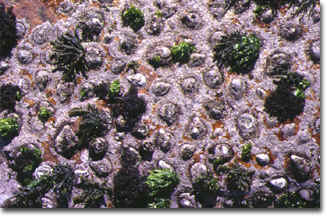
Coralline alga Spongites yendoi/
Derek Keats (CC BY-SA 3.0
Four hundred and thirty million years ago, according to ScienceDaily:
The discovery made by FAU palaeontologists Dr. Sebastian Teichert, Prof. Dr. Axel Munnecke and their Australian colleague Dr. William Woelkerling has far-reaching consequences. ‘Our finds mean that we must now look at the fossil record in a completely new way’, explains Dr. Sebastian Teichert. Up to now, a higher age for coralline red algae was thought to be so unlikely that fossils found in layers of rock older than the Cretaceous Period were not even considered as coralline red algae simply due to their age. The fossil record comprises all documented occurrences of fossils and is the essential source of information about how life on Earth developed. A re-evaluation of the fossils in the record could help scientists to answer new questions regarding the development of coralline red algae.
‘The fact that coralline red algae occur so much earlier in the Earth’s history sheds new light on several issues in ecology’, says Teichert. Red algae play an extremely important role in the world’s oceans today. For example, their calcareous skeletons ensure that coral reefs in the tropics remain stable and are even able to withstand heavy storms. In the Arctic, on the other hand, red algae take on the role of so-called ecosystem engineers. Their growth provides habitat for a large number of other organisms. Paper. (paywall) – Sebastian Teichert, William Woelkerling, Axel Munnecke. Coralline red algae from the Silurian of Gotland indicate that the order Corallinales (Corallinophycidae, Rhodophyta) is much older than previously thought. Palaeontology, 2019; DOI: 10.1111/pala.12418 More.
Note: “Red algae play an extremely important role in the world’s oceans today.” And they didn’t have a long time to organize themselves to be the ecology anchor either, it seems.
See also: Flowers bloomed in the early Jurassic, 50 million years earlier than thought
and
Feathers originated 70 million years earlier than thought It certainly is “amazing,” as Professor Benton says, that a complex array of features appeared 250 million years ago, rather abruptly, just as life was recovering from the Permian extinction. Would anyone have predicted that? Talk about “fossil rabbits in the Cambrian.”